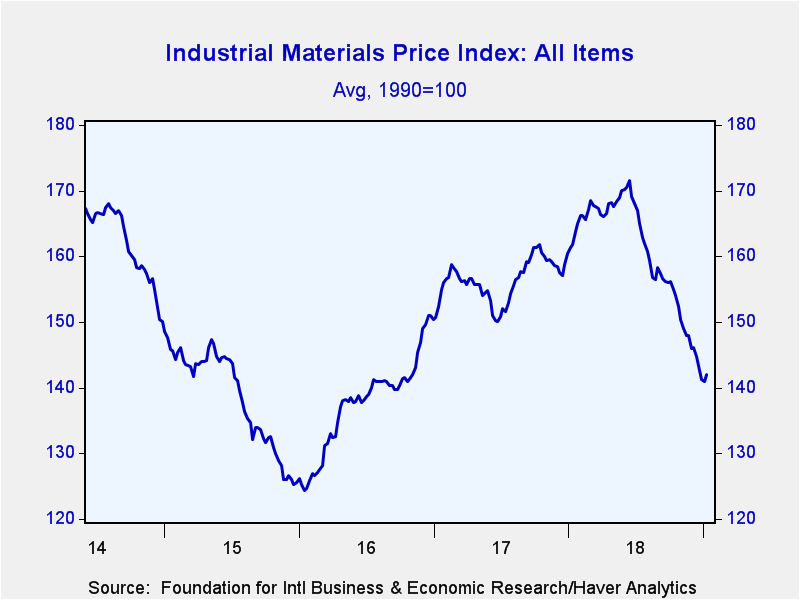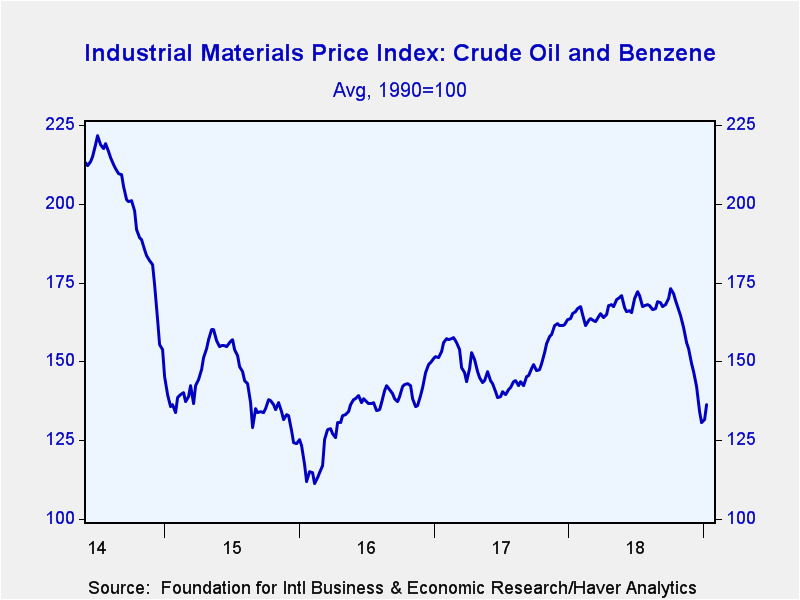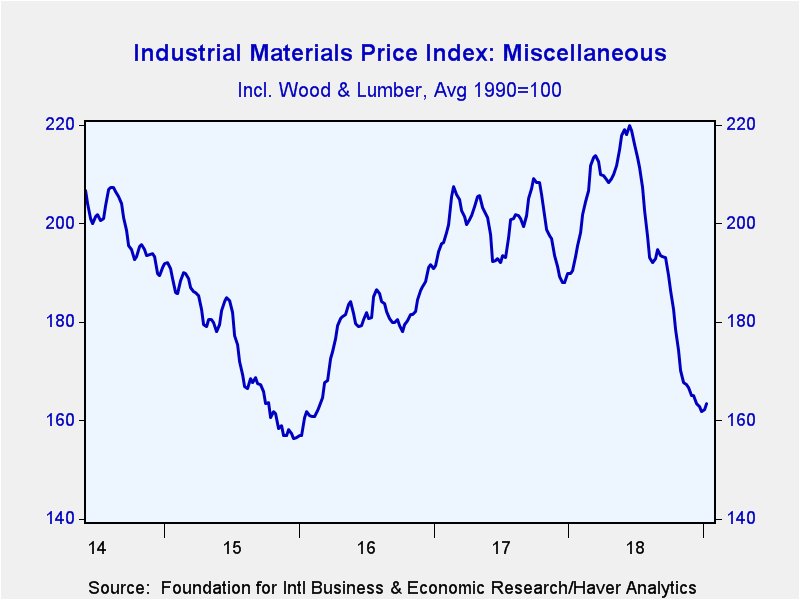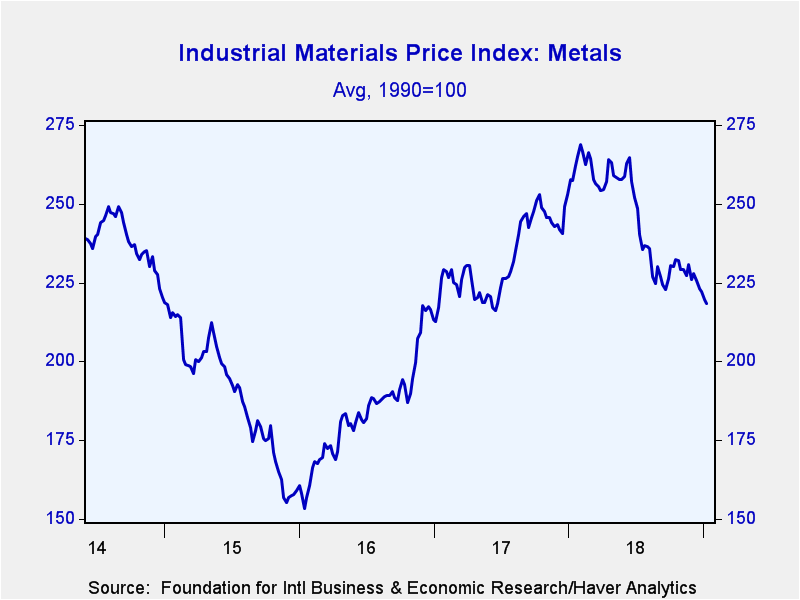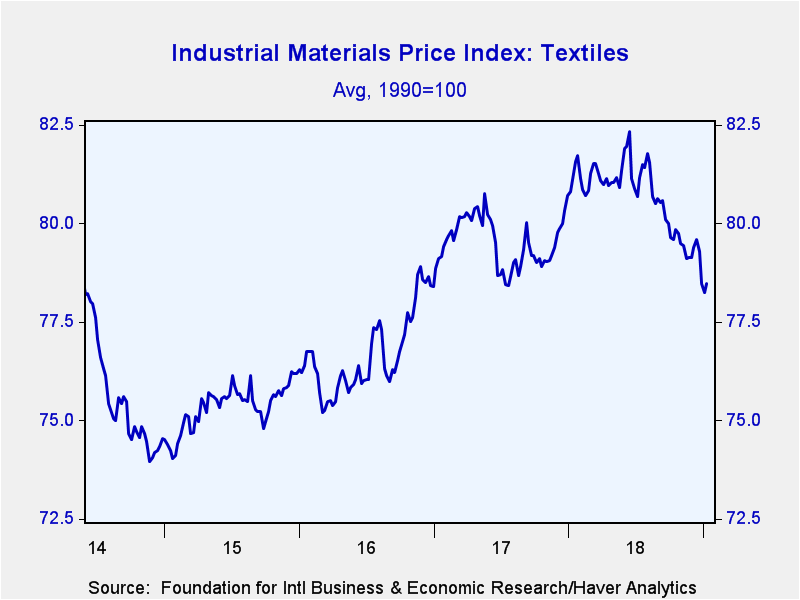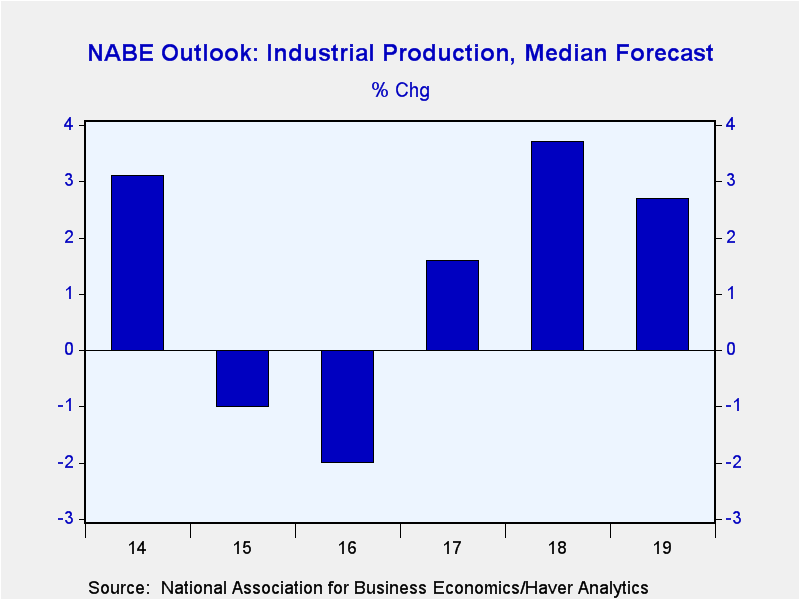 Global| Jan 14 2019
Global| Jan 14 2019FIBER: Industrial Commodity Prices Exhibit Broad-based Weakness
by:Tom Moeller
|in:Economy in Brief
Summary
The Industrial Materials Price Index from the Foundation for International Business and Economic Research (FIBER) has been weakening since late-June when the index reached its peak. During the last month alone, it's down 1.9% and over [...]
The Industrial Materials Price Index from the Foundation for International Business and Economic Research (FIBER) has been weakening since late-June when the index reached its peak. During the last month alone, it's down 1.9% and over the last year, it's fallen 12.3%.
A 17.4% y/y decline in prices in the crude oil & benzene category paced last year's decline. Crude oil prices fell to $45.02 per barrel by the end of the year, down from their $75.05 peak early in October. Last week, prices recovered to an average $50.22 per barrel. Prices for the petro-chemical benzene collapsed to roughly 180 cents per gallon from 280 cents in November. Prices in the miscellaneous group fell 14.2% y/y as of last week, led by a one-quarter decline in framing lumber prices. Structural panel prices were off 16.5% y/y. Earlier declines in rubber prices have stabilized, and they've risen 4.6% y/y. Metals prices posted a 15.1% y/y decline as of last week, paced by lead and zinc prices which fell 25.0% y/y and 26.0% y/y, respectively. And they have continued to soften. Copper scrap prices were down 17.0% y/y. Aluminum prices also weakened during the last year, off 14.8% y/y, and they too continue to soften. Steel scrap prices declined a lesser 2.8% y/y, but they've weakened sharply of late. In the textile group, prices fell 3.3% over the last year, led by an 11.3% y/y drop in cotton prices. Burlap prices declined 12.3% y/y, but most recently they have risen.
Weakness in industrial commodity prices occurred despite improvement in the factory sector. Overall manufacturing sector output has been fairly steady during the last few months and has risen 1.9% y/y. The consensus forecast from the National Association for Business Economics (NABE) calls for a 2.7% rise in industrial output during all of 2019. During the last ten years, there has been a 66% correlation between the y/y change in industrial commodity prices and the y/y change in factory sector output.
Commodity price data can be found in Haver's DAILY, WEEKLY, USECON and CMDTY databases. The NABE forecast is in the SURVEYS database.
Oil and Gas Sector Growth Stalls amid Sharp Oil Price Decline from the Federal Reserve Bank of Dallas is available here.
| FIBER Industrial Materials Price Index (%) | 1-Mth | 3-Mth | 6-Mth | 12-Mth | 2018 | 2017 | 2016 |
|---|---|---|---|---|---|---|---|
| All Items | -1.9 | -8.4 | -14.0 | -12.3 | -12.0 | 6.7 | 19.2 |
| Textiles | -1.4 | -1.4 | -3.3 | -3.3 | -2.8 | 3.0 | 2.8 |
| Cotton (cents per pound) | -9.6 | -6.6 | -18.2 | -11.3 | -9.2 | 9.8 | 10.2 |
| Metals | -3.2 | -5.0 | -9.0 | -15.1 | -12.2 | 18.6 | 32.9 |
| Aluminum ($ per metric ton) | -4.7 | -10.1 | -12.7 | -14.8 | -12.7 | 26.0 | 13.0 |
| Copper Scrap (cents per pound) | -4.2 | -4.9 | -5.9 | -17.0 | -16.1 | 29.3 | 17.3 |
| Steel Scrap ($ per ton) | -6.2 | -13.1 | -15.8 | -2.8 | 2.3 | 16.8 | 74.5 |
| Crude Oil & Benzene | -4.1 | -20.6 | -20.2 | -17.4 | -20.0 | 8.1 | 20.4 |
| Crude Oil (WTI, $ per Barrel) | -3.7 | -31.5 | -30.8 | -20.1 | -24.4 | 10.9 | 44.3 |
| Miscellaneous | -0.1 | -10.4 | -22.7 | -14.2 | -14.8 | -0.5 | 21.7 |
| Framing Lumber ($ per 1000 board ft.) | -3.2 | -15.4 | -39.3 | -24.5 | -23.1 | 20.0 | 12.9 |
| Natural Rubber (cents per pound) | 9.3 | 2.6 | 5.1 | 4.6 | -4.1 | -29.6 | 89.4 |
Tom Moeller
AuthorMore in Author Profile »Prior to joining Haver Analytics in 2000, Mr. Moeller worked as the Economist at Chancellor Capital Management from 1985 to 1999. There, he developed comprehensive economic forecasts and interpreted economic data for equity and fixed income portfolio managers. Also at Chancellor, Mr. Moeller worked as an equity analyst and was responsible for researching and rating companies in the economically sensitive automobile and housing industries for investment in Chancellor’s equity portfolio. Prior to joining Chancellor, Mr. Moeller was an Economist at Citibank from 1979 to 1984. He also analyzed pricing behavior in the metals industry for the Council on Wage and Price Stability in Washington, D.C. In 1999, Mr. Moeller received the award for most accurate forecast from the Forecasters' Club of New York. From 1990 to 1992 he was President of the New York Association for Business Economists. Mr. Moeller earned an M.B.A. in Finance from Fordham University, where he graduated in 1987. He holds a Bachelor of Arts in Economics from George Washington University.


